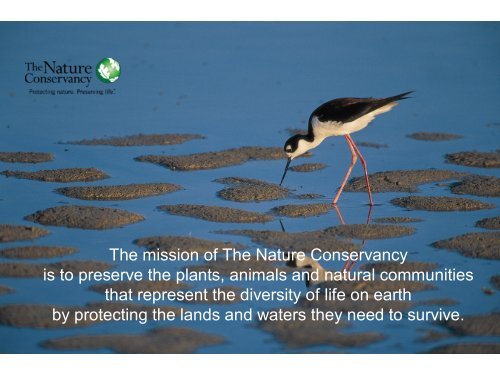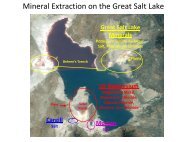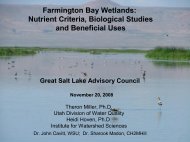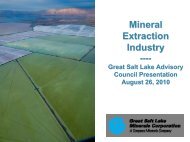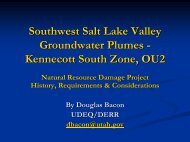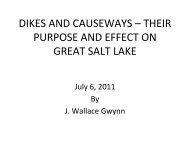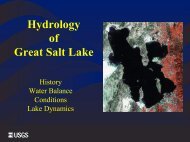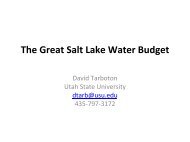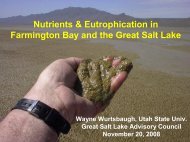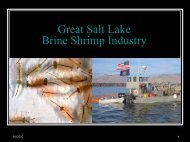The Nature Conservancy Presentation - Great Salt Lake Advisory ...
The Nature Conservancy Presentation - Great Salt Lake Advisory ...
The Nature Conservancy Presentation - Great Salt Lake Advisory ...
Create successful ePaper yourself
Turn your PDF publications into a flip-book with our unique Google optimized e-Paper software.
<strong>The</strong> mission of <strong>The</strong> <strong>Nature</strong> <strong>Conservancy</strong><br />
is to preserve the plants, animals and natural communities<br />
that represent the diversity of life on earth<br />
by protecting the lands and waters they need to survive.
GLOBALLY<br />
60 Years Old<br />
Works in U.S . and 38 countries<br />
1,000,000 Members<br />
3,700Staff Members<br />
119 Million Acres of Land Protected<br />
5,000 Miles of Rivers Preserved<br />
In UTAH<br />
238 Projects<br />
Over 900,000 Acres Protected<br />
7,000 Members<br />
400 Volunteers<br />
21 Staff Members<br />
© Mark Godfrey
17 Miles of Wild Strawberry River Protected
Cunningham Ranch, Book Cliffs
Deep Creek Mountains, West Desert
Final Populations of GloballyRare Plants and Wildflowers
350,000Acre Dugout Ranch
“<strong>The</strong> <strong>Great</strong> <strong>Salt</strong> <strong>Lake</strong> is ornithologically the most<br />
impressive salt lake on the continent.”<br />
Dr. Joseph R. Jehl<br />
500,000 Wilson’s Phalaropes / World’s largest staging concentration<br />
10,000 Snowy Plovers / World’s largest assemblage<br />
7,500 Whitefaced Ibis / World’s largest breeding population<br />
160,000 California Gulls / World’s largest breeding population<br />
250,000 American Avocets / Largest concentration in the Pacific Flyway<br />
65,000 Blacknecked Stilts / Largest concentration in the Pacific Flyway<br />
18,000 White Pelicans / One of the largest colonies in North America<br />
400,000 Eared Grebes / 2nd largest staging population in North America<br />
30,000 Marbled Godwits / Only staging site in U.S.<br />
500 Bald Eagles / 1 of Top 10 winter populations in U.S.<br />
11 Pairs Peregrine Falcon / Endagered species
Waterfowl on the <strong>Great</strong> <strong>Salt</strong> <strong>Lake</strong><br />
60,000 Tundra Swans<br />
1,000,000 Pintail<br />
100,000 Gadwall<br />
80,000 Cinnamon Teal<br />
500,000 Mallard<br />
60,000 Ruddy Ducks<br />
600,000 Greenwinged Teal<br />
50,000 Canada Geese<br />
150,000 Redhead<br />
50,000 Canvasback<br />
100,000 Shoveller
South End of <strong>Great</strong> <strong>Salt</strong> <strong>Lake</strong> Shorelands Preserve
North end of <strong>Great</strong> <strong>Salt</strong> <strong>Lake</strong> Shorelands Preserve
THREATS: Loss of wetland habitat due to subdivision and<br />
infrastructure development, loss of agricultural buffer lands, loss<br />
of water quantity, threatened water quality
12 shoreline miles<br />
43 transactions = 4,200 acres<br />
Largest naturallyfunctioning wetland<br />
complex on lakeshore
GSL Shorelands Preserve Visitor Center<br />
Dedicated June 18, 2004
Wings & Water<br />
Wetlands Education Program<br />
1,500 students per year<br />
25 naturalist guides<br />
Davis C0unty School Districts<br />
Annual Teacher Workshops
Acquisitions on GSL South Shore, Utah <strong>Lake</strong> & Bear River<br />
Refuge
Natural lake level fluctuation over time
What does this time lapse sequence<br />
indicate<br />
are the processes or characteristics of a<br />
naturallyfunctioning GSL system<br />
1. <strong>Lake</strong> level fluctuation<br />
2. <strong>Lake</strong> Circulation / Salinity Balance<br />
3. Water Quality<br />
4. Water Quantity
Discharge Proposals
Infrastructure Development: Legacy Highway
Mineral<br />
Extraction<br />
Expansion<br />
Proposals
Nutrients in Farmington Bay
Utah Waterfowl Mercury Advisories<br />
Cinnamon Teal<br />
Northern Shoveler<br />
Common Goldeneye
Insert slide of Spiral Jetty<br />
Here<br />
Oil Leasing & Viewsheds
Air Quality / Human Health Issues
Lessons learned from controversial<br />
issues….<br />
1. <strong>Lake</strong> is finite<br />
2. All beneficial uses are more interconnected<br />
than we thought (“zoning” dilemma)<br />
3. No clear definition of lake health<br />
4. Mandate to protect/utilize not clearly<br />
articulated<br />
5. “Coordinated Management” leaves out wholesystem<br />
health<br />
6. Inadequate science data for decisionmaking<br />
7. No “limits” set for any beneficial use<br />
8. No tracking of cumulative effects of all<br />
permitted uses<br />
9. Some state agency charters/purposes do<br />
conflict<br />
10. No single entity with final analysis<br />
responsibility and final decisionmaking
To Move Forward Towards….<br />
A Healthy <strong>Lake</strong> System, Sustainable Uses, Reduced<br />
Conflict<br />
1. Clarify underlying state responsibilities<br />
2. Develop measurable definition of GSL<br />
health<br />
3. Improve planning and decisionmaking processes<br />
4. Expand the role of science<br />
5. Create a Commission/Council with appropriate vision,<br />
authority, structure and funding
Conservation By Design


